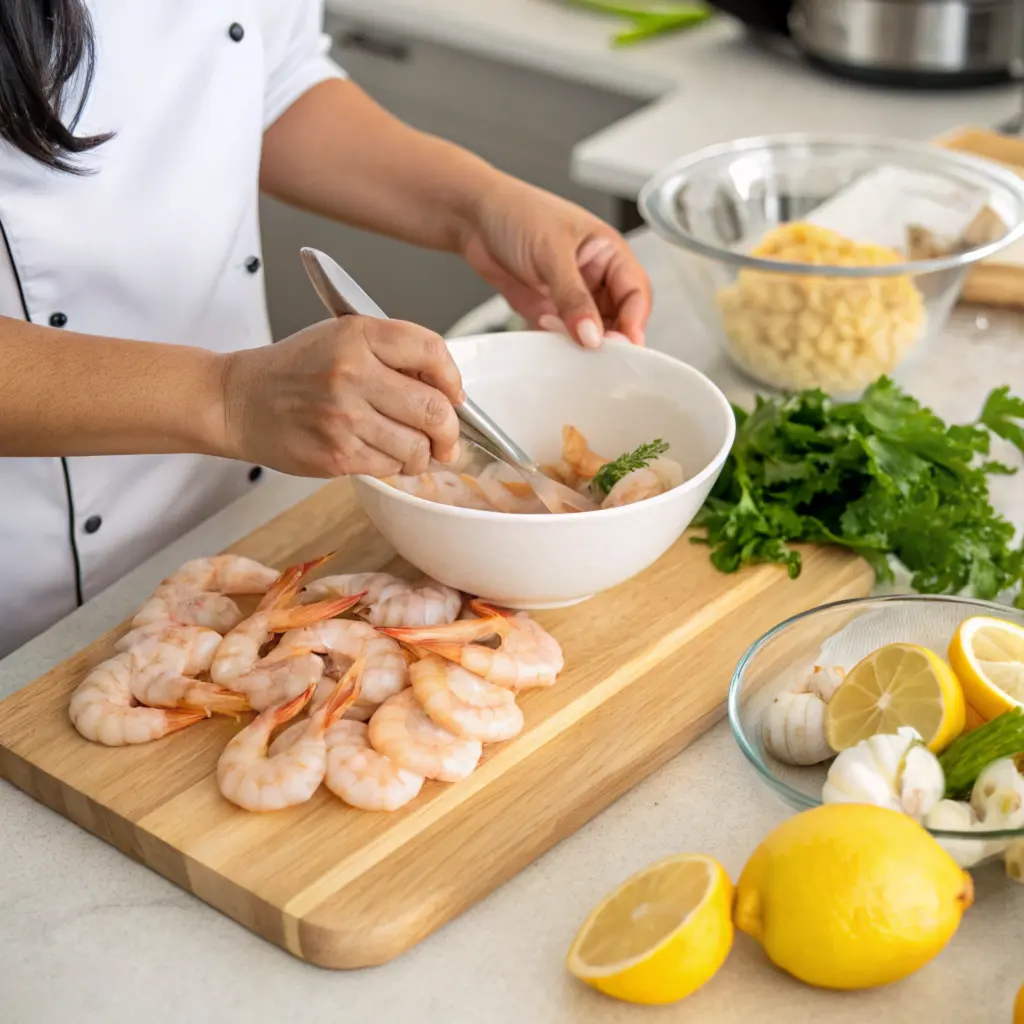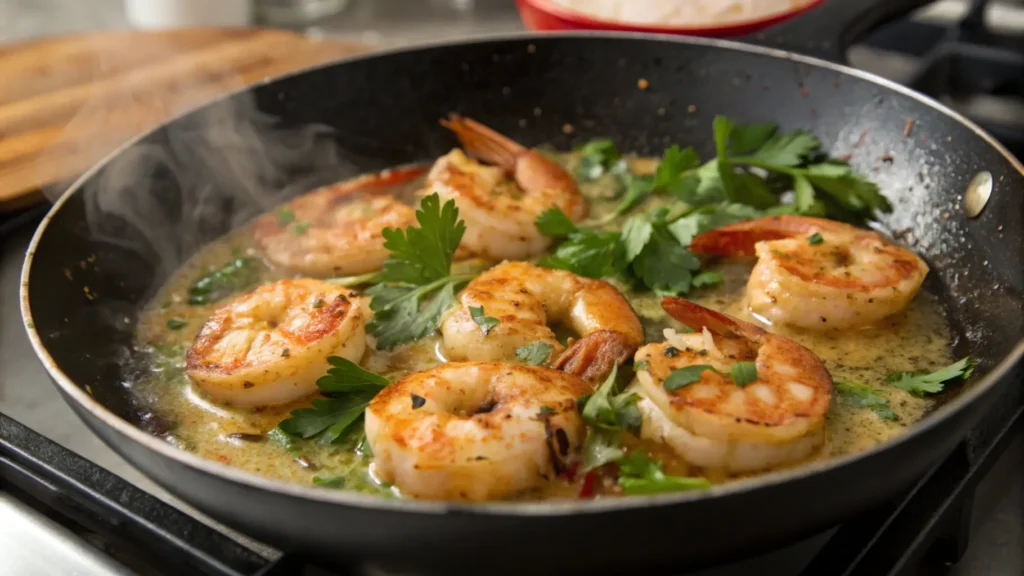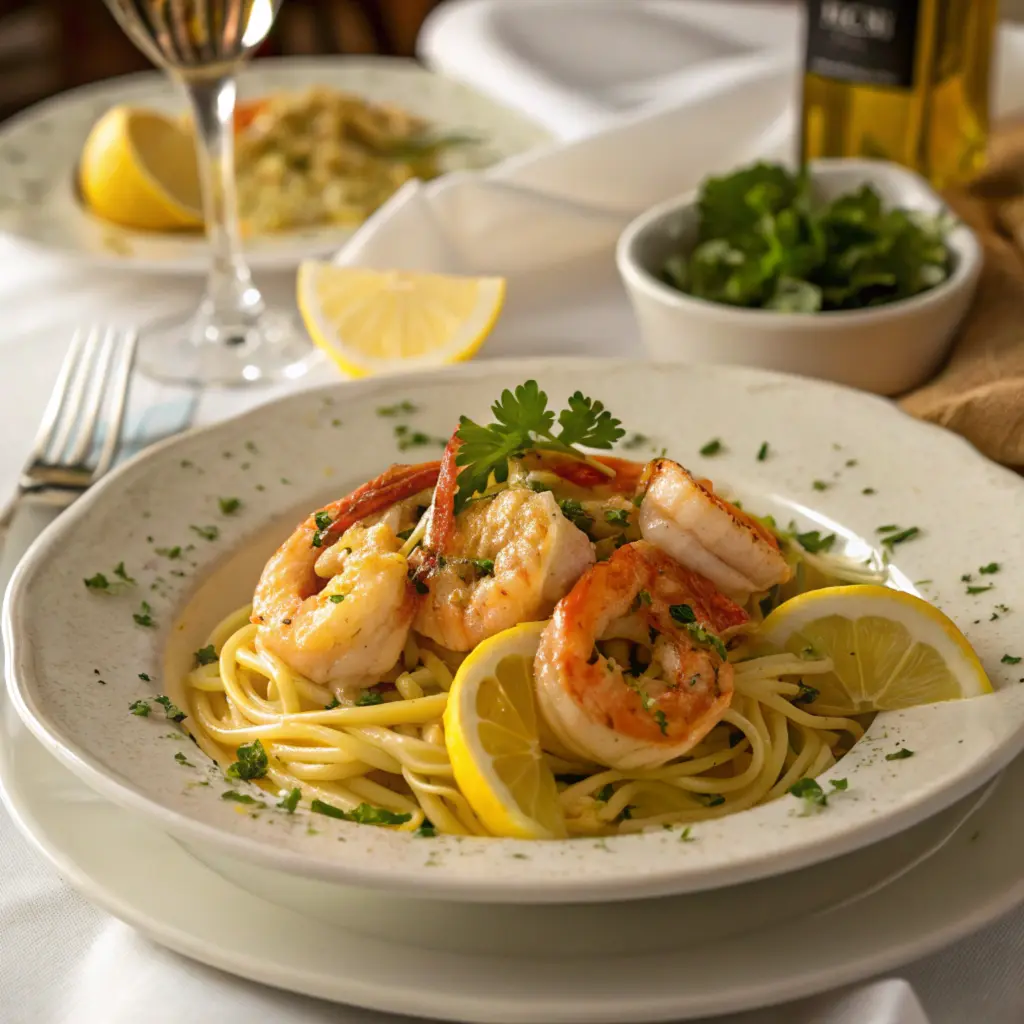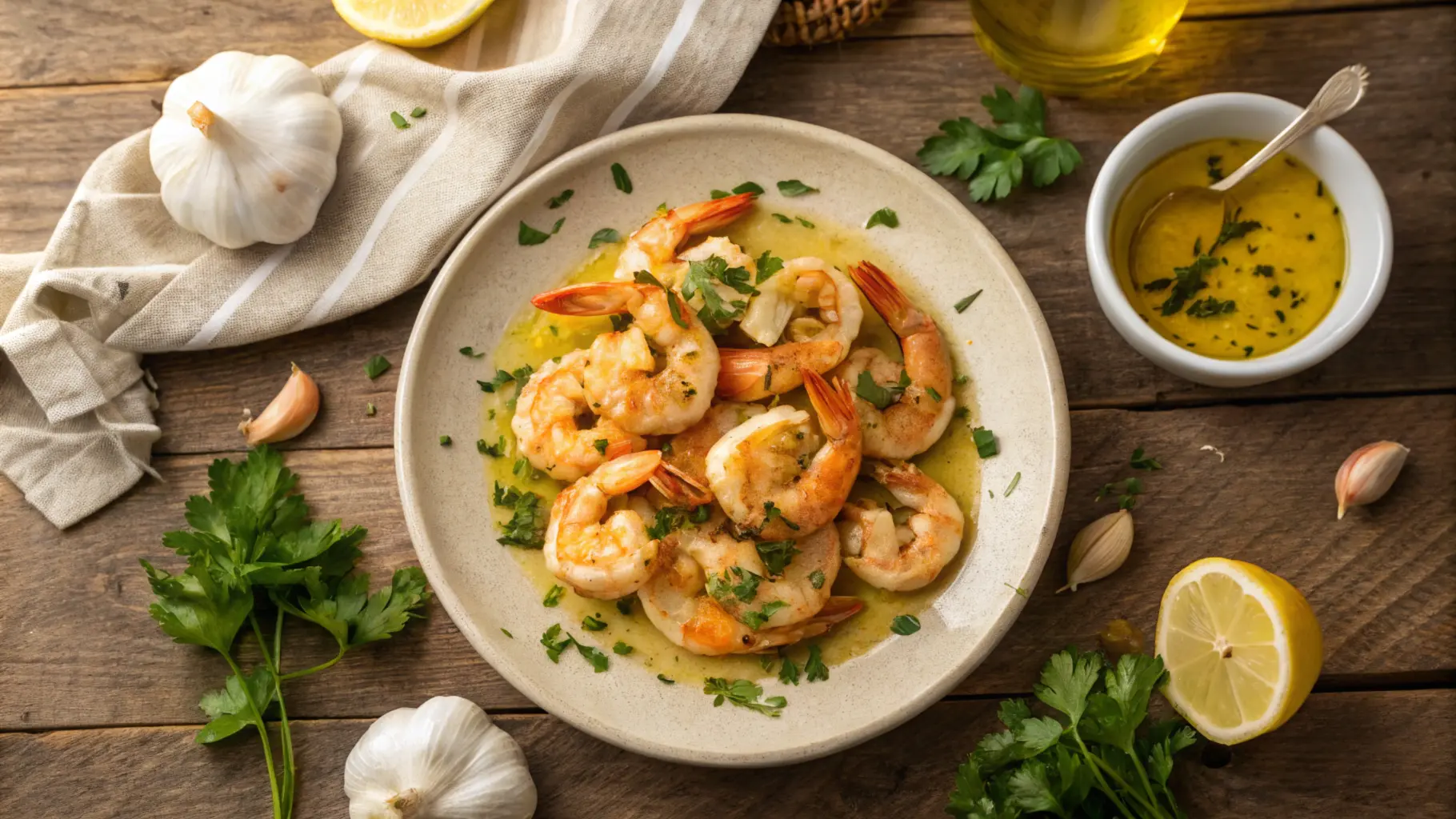Shrimp lovers, rejoice! This article takes you through the perfect garlic shrimp recipe step by step. From selecting fresh shrimp to achieving the right flavors and textures, you’ll find everything you need for a lip-smacking dish. Whether you’re new to cooking shrimp or looking for tips to refine your technique, this guide has got you covered. Let’s get started!
For a rich and flavorful addition to your shrimp dishes, try this recipe for Garlic Butter.
What is Garlic Shrimp?
Garlic shrimp is a delightful dish bursting with flavors of garlic, butter, and perfectly cooked shrimp. Loved globally for its simplicity, it’s a versatile recipe that can be served as a starter or main course. Whether sautéed or baked, it never fails to impress.
Nutritional Benefits of Shrimp
Shrimp isn’t just tasty—it’s also packed with health perks! Rich in lean protein, shrimp provides essential nutrients like omega-3 fatty acids, selenium, and vitamin B12. Plus, it’s low in calories, making it a fantastic choice for wholesome meals.
Did you know? A serving of shrimp is not only satisfying but also heart-healthy. Its natural sweetness pairs beautifully with garlic, creating a flavor-packed meal that’s both nutritious and satisfying.
A Quick Glimpse into the Recipe’s Popularity
From Hawaiian-style garlic shrimp to simple sautéed versions, this dish has many regional variations. Its charm lies in its adaptability, working just as well with rice, pasta, or vegetables. The irresistible combination of garlic and butter is universally adored, making this recipe a timeless classic.
Choosing Fresh Shrimp
Fresh vs. Frozen Shrimp
When it comes to making garlic shrimp, your choice of shrimp can make all the difference. Fresh shrimp, often considered the gold standard, boasts a sweeter and more delicate flavor. However, don’t overlook frozen shrimp—it’s typically flash-frozen right after harvest, locking in freshness. Frozen shrimp also offers convenience and availability year-round, making it a reliable option for many home cooks.
If you choose frozen shrimp, be sure to thaw it properly in the refrigerator or under cold running water before cooking. Avoid quick thawing methods like microwaving, as they can affect texture. Both fresh and frozen shrimp work beautifully in this recipe when handled correctly.
Indicators of Freshness
Selecting fresh shrimp is all about paying attention to key signs of quality. Look for shrimp with firm, translucent flesh and a mild, ocean-like smell. The shells should be intact, shiny, and moist—not slimy or dry. For head-on shrimp, clear and glossy eyes indicate freshness.
To make the best choice, follow these Shrimp Selection and Storage Tips provided by the FDA to ensure you’re buying shrimp that’s safe and high-quality. Avoid shrimp with a strong ammonia odor, black spots on the shell, or a limp texture. Proper selection guarantees your dish will taste its best.
The Role of Garlic in Flavor
Garlic is the star ingredient in garlic shrimp, and its bold, savory taste is what sets this dish apart. When sautéed, garlic develops a sweet, nutty aroma that perfectly complements the natural sweetness of shrimp. Its powerful flavor infuses the butter or oil, creating a mouthwatering base that elevates the entire dish.
For the best results, use fresh garlic cloves rather than pre-minced garlic. Fresh cloves have a sharper and more vibrant taste, while pre-minced options can often be bland. To test garlic freshness, gently squeeze the bulb—it should feel firm and tightly packed. Look for bulbs with unblemished, papery skins and avoid any with sprouting or soft spots.
Pro tip: Mince the garlic just before cooking to preserve its aroma and avoid bitterness. With the right garlic, your shrimp will be brimming with unforgettable flavor.
Selecting the Appropriate Cooking Fat
Butter and olive oil are the two most popular choices for cooking garlic shrimp, and each brings unique qualities to the dish.
Butter adds a rich, creamy texture and enhances the shrimp’s natural sweetness. It also browns beautifully, creating a nutty flavor that pairs well with garlic. However, butter has a lower smoke point, so it requires careful temperature control to prevent burning.
Olive oil, on the other hand, offers a lighter, fruitier flavor profile. It’s a healthier option, rich in heart-friendly monounsaturated fats. Olive oil’s higher smoke point makes it more forgiving during sautéing, especially for those new to cooking shrimp.
For the ultimate balance, many cooks use a mix of both. Start with olive oil for high-heat cooking, then finish with butter for its luxurious taste. By understanding how each fat influences the recipe, you can create a dish that’s both flavorful and perfectly cooked.
Cleaning and Deveining Shrimp

To create the best garlic shrimp recipe, cleaning and deveining your shrimp is an essential step. Proper preparation ensures the shrimp cooks evenly and maintains a clean, fresh taste. Follow these simple steps to get it done right:
- Rinse the Shrimp
Start by rinsing the shrimp under cold water to remove any surface debris or grit. Pat them dry with a paper towel for easier handling. - Remove the Shells
If your recipe calls for peeled shrimp, gently peel away the shell. Begin at the legs, working your way around until the shell is completely removed. Leave the tails on for presentation, or remove them based on your preference. - Locate the Vein
The “vein” is actually the digestive tract, often visible as a dark line along the shrimp’s back. While it’s safe to eat, removing it improves the dish’s appearance and texture. - Devein the Shrimp
Using a paring knife or shrimp deveiner, make a shallow incision along the back of the shrimp. Carefully lift and pull out the vein with the tip of the knife or your fingers. Discard the vein and rinse the shrimp again. - Final Rinse and Drying
Give the shrimp one last rinse to remove any remaining debris. Lay them on a clean towel to dry. Now, your shrimp is clean, deveined, and ready to cook.
Proper cleaning not only elevates your dish’s quality but also ensures a pleasant dining experience.
Marinating for Maximum Flavor
Marinating shrimp is a game-changer when it comes to building flavor. While shrimp naturally absorbs seasonings well, marinating allows spices, herbs, and oils to penetrate the surface, resulting in tender, flavorful bites.
Why Marinate Shrimp?
Marinating helps infuse your shrimp with layers of taste. Garlic, olive oil, and lemon juice make a classic base for marinades, while optional ingredients like paprika or chili flakes add a kick. A well-marinated shrimp is more flavorful and stays juicy even after cooking.
How to Marinate Shrimp
Combine olive oil or melted butter with minced garlic, lemon juice, and your favorite herbs like parsley or cilantro. Add a pinch of salt and pepper for seasoning. Coat the shrimp evenly with the mixture and let it sit in the refrigerator for 15 to 30 minutes. Avoid marinating for too long—shrimp is delicate, and prolonged marination can alter its texture.
Pro tip: If you’re short on time, even a quick 10-minute marinade can make a noticeable difference. For bold variations, experiment with soy sauce, honey, or smoked paprika in the mix.
Once marinated, your shrimp will be primed to deliver mouthwatering flavors in every bite!
Sautéing Shrimp to Perfection
Ideal Cooking Temperatures for Sautéing Garlic Shrimp

Sautéing shrimp for the perfect garlic shrimp recipe requires careful temperature control. Start by preheating your skillet over medium-high heat—this ensures the shrimp develop a golden-brown exterior without overcooking. Add a splash of olive oil, butter, or a combination of both, and wait until it begins to shimmer. The shimmering indicates the oil is hot enough to sear the shrimp while locking in their juices.
If the pan is too cold, shrimp will release excess moisture, leaving you with a rubbery texture instead of the firm, tender bite you want. On the other hand, if the heat is too high, you risk burning the butter or garlic, which can impart a bitter taste. Aim for a balance where the pan is hot but not smoking, letting the flavors meld perfectly.
Timing for Optimal Texture When Sautéing Garlic Shrimp
When sautéing shrimp, timing is everything. Lay the shrimp in a single layer, ensuring they don’t overlap or crowd the pan—this promotes even cooking. Shrimp should cook for 2-3 minutes per side. Flip them as soon as they turn pink and opaque.
A key visual cue is the shrimp’s shape: they should curl into a gentle “C.” If they form a tight “O,” it’s a sign of overcooking. Overcooked shrimp lose their tenderness and become chewy.
For the best results, test one shrimp for doneness before completing the batch. Once the shrimp are cooked through, remove them from the pan immediately to prevent residual heat from continuing the cooking process. Proper timing ensures the shrimp remain juicy, tender, and perfectly infused with the bold flavors of garlic and butter.
Alternative Cooking Methods
Grilling Garlic Shrimp: A Smoky Twist on How to Cook Garlic Shrimp Recipe
Grilling is a fantastic way to prepare garlic shrimp, adding a smoky, charred element that complements the garlicky richness of this dish. The open flame enhances the natural sweetness of the shrimp while locking in the flavors of the marinade.
To start, thread the marinated shrimp onto skewers for easy flipping and even cooking. If using wooden skewers, soak them in water for 20-30 minutes beforehand to prevent burning. Preheat your grill to medium-high heat and lightly oil the grates to keep the shrimp from sticking.
Place the skewers on the grill and cook the shrimp for 2-3 minutes on each side. Flip them only once, ensuring they develop beautiful grill marks while turning pink and slightly charred. Remember, shrimp cook quickly, so don’t walk away!
For added flavor, baste the shrimp with garlic butter as they cook. This not only intensifies the garlicky goodness but also keeps the shrimp juicy and flavorful. Grilled garlic shrimp recipe pairs wonderfully with grilled zucchini, asparagus, or a refreshing side salad.
Perfect for outdoor barbecues or summer dinners, grilling your garlic shrimp recipe offers a unique and delicious take on this classic dish.
Baking Garlic Shrimp
Baking offers a hands-off approach that’s ideal for busy cooks. Preheat your oven to 400°F (200°C) and arrange marinated shrimp in a single layer on a baking sheet or in a casserole dish. Drizzle with melted garlic butter and sprinkle with herbs for added aroma.
Bake for 8-10 minutes, or until the shrimp are pink and just cooked through. If you like a slightly crispy texture, finish under the broiler for 1-2 minutes. Baking preserves the shrimp’s tenderness and is a fantastic method for preparing larger batches without constant supervision.
Both methods deliver delicious results, so you can choose based on your preferred cooking style or occasion!
Ingredients for a Rich Sauce
A good garlic butter sauce is the soul of a perfect garlic shrimp recipe. It’s rich, aromatic, and effortlessly elevates the dish. Here are the essential components:
- Butter: This is the foundation of the sauce. Unsalted butter is ideal as it allows you to control the saltiness. Butter lends creaminess and depth, creating a luscious coating for the shrimp.
- Garlic: Freshly minced garlic is key. Its bold, slightly sweet flavor shines when gently sautéed in butter. Avoid pre-minced garlic, as it can taste dull.
- Olive Oil: Combining olive oil with butter enhances the sauce’s flavor and prevents the butter from burning. Choose high-quality extra virgin olive oil for the best results.
- Lemon Juice: A splash of freshly squeezed lemon juice balances the richness with a refreshing tang. It also adds a subtle brightness to the dish.
- Herbs: Fresh parsley is a classic addition, adding a pop of color and an herby freshness. You can also use cilantro or thyme for variation.
- Seasonings: Salt, black pepper, and optional chili flakes bring the flavors together. Adjust the seasoning to taste for a perfect blend.
These simple ingredients combine to create a sauce that’s both flavorful and versatile, beautifully complementing the shrimp.
Achieving the Perfect Consistency
Creating a smooth and rich garlic butter sauce requires a delicate balance of ingredients and technique. Follow these tips for perfection:
- Start with Room Temperature Butter
Using room-temperature butter helps it melt evenly without separating. Cold butter can lead to lumps, while overly hot butter may break the sauce. - Cook Garlic Gently
Sauté garlic over low to medium heat until fragrant. Avoid browning or burning it, as this can result in bitterness. Stir constantly to ensure even cooking. - Incorporate Liquids Gradually
When adding olive oil, lemon juice, or broth, pour in small amounts while stirring continuously. This helps emulsify the sauce, creating a silky texture. - Whisk for Smoothness
A whisk works wonders for achieving consistency. Stirring vigorously while combining ingredients prevents separation and ensures everything melds together. - Adjust Thickness
If the sauce seems too thick, thin it with a splash of shrimp stock, water, or a little more olive oil. If it’s too thin, simmer gently until it reduces to your desired thickness.
By following these steps, you’ll craft a sauce that’s irresistibly creamy and perfectly coats every shrimp, making every bite unforgettable.
Pairing Garlic Shrimp with Sides: Perfect Complements for How to Cook Garlic Shrimp Recipe
The charm of the garlic shrimp recipe lies in its versatility, making it an ideal centerpiece for countless side dishes. Whether you prefer comforting carbs or fresh vegetables, these pairings can turn your shrimp into a satisfying and complete meal.

Pasta and Rice Options
- Pasta: Pairing garlic shrimp with pasta is a classic combination. Toss linguine, spaghetti, or angel hair in the savory garlic butter sauce for a dish that’s rich and indulgent. Top with freshly grated Parmesan cheese and a sprinkle of parsley to elevate the flavors further.
- Rice: Fluffy white rice or fragrant jasmine rice is excellent for soaking up the garlic butter sauce. If you’re looking for something more substantial, try wild rice or a herbed pilaf for added texture and taste. For a low-carb alternative, cauliflower rice works wonderfully and keeps the meal light.
- Risotto: Creamy garlic-infused risotto pairs decadently with shrimp. Add a hint of Parmesan to complement the rich sauce, creating a harmonious flavor profile.
Vegetable Accompaniments
- Roasted Vegetables: Garlic shrimp and roasted vegetables are a match made in heaven. Try asparagus, zucchini, or cherry tomatoes drizzled with olive oil and lightly seasoned. The caramelized edges add depth and contrast to the buttery shrimp.
- Steamed Greens: For a simple and healthy pairing, serve garlic shrimp with steamed broccoli, green beans, or spinach. A squeeze of lemon over the greens brightens the dish and ties the flavors together.
- Salads: A crisp green salad with a zesty vinaigrette or a tangy arugula salad pairs beautifully with the richness of garlic shrimp. Adding citrus or herbs to the salad enhances the overall freshness of the meal.
By choosing the right sides, your garlic shrimp recipe becomes a versatile feast that pleases any palate.
Flavor Pairings for How to Cook Garlic Shrimp Recipe
Traditionally, seafood dishes are accompanied by wine, but there are plenty of delicious non-alcoholic options that pair beautifully with a garlic shrimp recipe. These beverages bring out the dish’s flavors while offering a refreshing complement:
Non-Alcoholic Pairing Suggestions
- Lemon Iced Tea: The tartness of lemon iced tea cuts through the richness of the garlic butter sauce, creating a refreshing balance. The citrus notes enhance the natural sweetness of the shrimp, making every bite more vibrant.
- Sparkling Water with Citrus: A glass of sparkling water with a twist of lime or lemon offers a clean and palate-cleansing experience. The effervescence refreshes your taste buds between bites, keeping the meal light and enjoyable.
- Herbal Teas: For a warm and soothing option, consider mint or chamomile tea. These delicate flavors don’t compete with the boldness of the garlic shrimp, providing a gentle contrast that harmonizes the meal.
By pairing your garlic shrimp recipe with one of these beverages, you can create a delightful and satisfying dining experience without the need for alcohol.
Regional Twists on How to Cook Garlic Shrimp Recipe
How to cook garlic shrimp recipe varies across regions, with each culture adding its own spin to this classic dish. Let’s explore how different parts of the world put their signature touch on this flavorful favorite:
Filipino-Style Garlic Butter Shrimp Recipe
In the Philippines, garlic butter shrimp is a beloved staple, often enjoyed with steamed rice. This version keeps the shrimp shell-on to enhance flavor and retain moisture. Garlic is sautéed in butter until aromatic, then soy sauce and soda are added, creating a sweet-savory glaze. Optional ingredients like chili flakes or coconut milk offer a spicy or creamy variation, making this dish adaptable to personal preferences.
The result is a bold mix of garlic, sweetness, and umami flavors. Serve it family-style with rice to enjoy an authentic Filipino garlic butter shrimp recipe.
Hawaiian Garlic Shrimp Recipe
Hawaiian-style garlic shrimp is famous for its food truck origins and beachside charm. Large shrimp are cooked with their shells intact, allowing the buttery, garlicky sauce to seep in. The sauce is thickened with a touch of flour and infused with crushed garlic and paprika for a smoky twist.
Served over sticky white rice with a lemon wedge, this variation of the garlic shrimp recipe brings tropical vibes and a rich, savory taste that’s perfect for casual dining or summer gatherings.
Dietary Modifications for Garlic Shrimp Recipe
Low-Carb and Keto-Friendly Garlic Shrimp Recipe Options
For a keto-friendly garlic shrimp recipe, skip traditional sides like pasta or rice and serve the shrimp over zucchini noodles, cauliflower rice, or a crisp green salad. Replace sweeteners in marinades with keto-friendly alternatives like stevia or monk fruit. Garlic-infused olive oil adds a flavorful touch while keeping the dish low in carbs.
Adding Parmesan cheese as a garnish can bring extra richness without compromising keto guidelines, ensuring a satisfying meal.
Dairy-Free Garlic Butter Shrimp Recipe Alternatives
Creating a dairy-free version of the classic garlic butter shrimp recipe is simple. Swap butter for plant-based alternatives like vegan margarine, coconut oil, or avocado oil. These options maintain the sauce’s creamy texture while being dairy-free.
For an even richer sauce, use cashew cream or almond milk as a base. Fresh garlic and olive oil ensure the dish retains its bold, signature flavor. Garnish with fresh herbs for an added burst of color and aroma. These modifications make the recipe accessible to everyone, regardless of dietary restrictions.
Avoid Overcooking When Preparing How to Cook Garlic Shrimp Recipe
One of the biggest mistakes in making the perfect garlic shrimp recipe is overcooking. Shrimp are naturally tender and cook very quickly, so it’s easy to accidentally leave them on the heat too long. Unfortunately, overcooked shrimp lose their juicy texture and become tough and rubbery.
As shrimp cook, their natural moisture evaporates. Overcooking not only affects the texture but also diminishes the shrimp’s sweet flavor, making it less enjoyable. To avoid this, careful timing and observation are essential.
When preparing your garlic shrimp recipe, cook shrimp on medium-high heat for 2-3 minutes per side. Look for clear visual cues: the shrimp should turn opaque with a pinkish hue and curl into a loose “C” shape. Avoid letting them curl into a tight “O,” as this signals overcooking.
A digital thermometer can be a handy tool; shrimp are perfectly cooked at an internal temperature of 120°F (49°C). If you’re cooking multiple batches, transfer the finished shrimp to a plate immediately to prevent residual heat from continuing the cooking process. Paying attention to these details ensures tender, flavorful shrimp every time.
Balancing Garlic Flavor in How to Cook Garlic Shrimp Recipe
Garlic is the defining ingredient in how to cook garlic shrimp recipe, but too much garlic can overwhelm the dish. Achieving the right balance is key to complementing the shrimp without overpowering its natural sweetness.
Start with 3-4 cloves of fresh garlic for most recipes. Finely mince the garlic for an intense flavor or slice it for a milder, more gradual infusion. If you want to experiment, try roasting garlic before adding it to your sauce—this process mellows its sharpness and brings out a sweet, nutty profile.
When cooking, sauté garlic over low to medium heat in butter or olive oil. Stir constantly to prevent burning, as browned garlic turns bitter. Add the shrimp once the garlic is fragrant and golden to ensure the flavors blend seamlessly.
For a layered garlic experience, you can use a combination of raw and cooked garlic. Cook the majority in the sauce, but save a small portion to sprinkle raw over the finished dish for a burst of fresh flavor. With these tips, your garlic shrimp recipe will have just the right level of garlicky goodness.
Frequently Asked Questions
What sauces go well with shrimp?
Shrimp pairs well with a variety of sauces, each adding its own unique twist to the dish. Classic options include garlic butter sauce, cocktail sauce, and lemon dill sauce. For a spicy kick, try remoulade or sriracha mayo. Asian-inspired sauces like soy-ginger glaze or Thai sweet chili sauce are also popular. Each sauce complements the shrimp’s natural sweetness, enhancing the overall flavor.
Shrimp pairs wonderfully with a variety of sauces, from tangy cocktail sauce to creamy garlic butter. For a full list of delicious sauce ideas, visit this guide.
What’s the tastiest way to cook shrimp?
The tastiest way to cook shrimp depends on personal preference, but sautéing in garlic butter is a timeless favorite. It’s quick, easy, and creates a flavorful, aromatic dish. Grilling shrimp adds a smoky char, while baking locks in moisture and produces a tender texture. Marinating shrimp before cooking can boost its flavor, making any method you choose even more delicious.
There are many delicious ways to cook shrimp, from sautéing to grilling and beyond. For a comprehensive guide on what’s the tastiest way to cook shrimp, check out this article.
What is shrimp with garlic sauce made of?
Shrimp with garlic sauce typically features a rich blend of butter, garlic, olive oil, and seasonings like salt, pepper, and parsley. Lemon juice adds a zesty brightness, while optional ingredients like chili flakes or paprika give it a spicy edge. The simplicity of these ingredients allows the shrimp’s natural flavors to shine through.
Why do you soak shrimp in milk before frying?
Soaking shrimp in milk before frying is a technique used to enhance texture and flavor. Milk helps tenderize the shrimp and neutralizes any fishy odors, leaving a clean taste. It also creates a slight coating on the shrimp, helping seasonings and batter stick better for a crispier finish.
Soaking shrimp in milk before frying helps to tenderize the shrimp and remove any fishy odors. You can learn more about this technique and why it works in detail here.
Bringing It All Together: How to Cook Garlic Shrimp Recipe
Cooking garlic shrimp is a simple yet rewarding culinary adventure that transforms basic ingredients into a flavorful masterpiece. From selecting fresh or frozen shrimp to crafting a rich garlic butter sauce, each step contributes to the dish’s success. Choosing the right cooking method—be it sautéing, grilling, or baking—helps achieve the perfect texture and taste. Pairing the shrimp with complementary sides like pasta, rice, or vegetables further enhances your dining experience.
To ensure success, avoid overcooking the shrimp to maintain their juicy, tender quality, and balance the garlic flavor to create a bold yet harmonious profile. Whether you prefer the smoky charm of grilled garlic shrimp or the buttery richness of Filipino and Hawaiian variations, this dish offers endless possibilities to suit your taste.
Now it’s time to get creative! Experiment with different seasonings, sides, and preparation techniques to make the garlic shrimp recipe your own. Armed with these tips and ideas, you’re ready to serve a dish that’s sure to impress every time.

